Facebook has 1.65 billion active users. And you market there.
Twitter has 310 million active users. You probably market there, too.
LinkedIn has 100 million active users. You’re on there, connecting and endorsing people for skills like “Excel Spreadsheets” and “Eating.”
But I bet you’re not marketing on a platform that has one billion users.

Yep. WhatsApp, the SMS-based platform, has more users than Instagram, LinkedIn, Twitter and Pinterest combined. They passed the one billion user mark this year, reaching every corner of the world (except Antarctica, but c’mon).
Not only that, but it’s kicking the ever-living life out of email. Email marketing is crucial, but think about this for a second: What’s your highest open rate? 35%? 40%?
Yeah. The average SMS text has a 98% open rate. That makes WhatsApp the most engaging marketing channel on the planet.
We’re talking about a platform that is literally taking the world by storm. A high-reach, high-engagement platform that hit 450 million monthly active users faster than any company in existence.

Source: ComScore
But I guarantee only the tiniest fraction of you actually uses WhatsApp. That’s because there just hasn’t been a way for marketers to correctly use WhatsApp.
There’s no advertising on WhatsApp. In fact, this is how they feel about advertisers:

Needless to say, they aren’t fans. This a free service that is intentionally designed to keep marketers out.
Well…until now, that is. Call me the WhatsApp Trojan Horse.
- You can’t track your success on a nice dashboard.
- You can’t boost your message by throwing dollars behind it
- You can’t search for groups to automatically join and promote your stuff.
But you do have the chance to win early on a highly underutilized platform. You can build a massive following and drive consistent, engaged traffic to your site.
And I’m going to show you how to do that by cracking the WhatsApp code.

What Is WhatsApp, Anyway?
WhatsApp is an app solution that eliminates expensive SMS texting fees. Instead of paying crazy data fees, you can use WhatsApp and send messages for free to anyone in the world.
Want to send a text message from Canada to the US? $0.
A text from Russia to your friend in Hong Kong? $0.
All that is free on WhatsApp.
WhatsApp was created in 2009 by two ex-Yahoo employees who wanted to make free communication available to all. They were the fastest to 450 million active monthly users, and in 2014 Facebook acquired them for $16 billion.
It was the largest acquisition in the history of Silicon Valley. It was 20x larger than the Instagram acquisition, and Facebook reportedly doubled Google’s bid to make sure they acquired WhatsApp.
Yeah. That’s how much Facebook believes in this app.
The cool part is you’re not limited to just text-based messages. You can send images:

Your location:
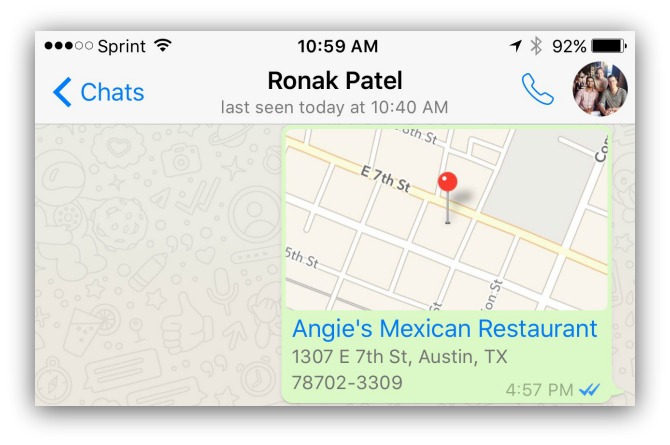
Voice messages:
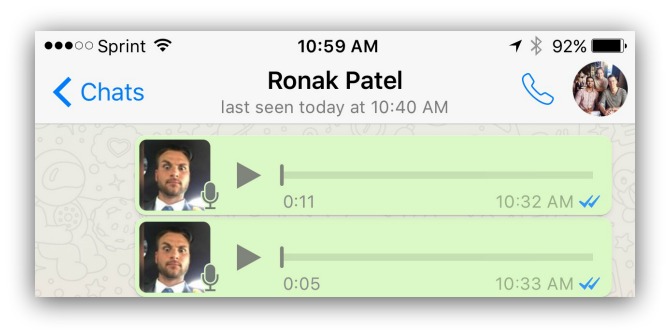
Videos:
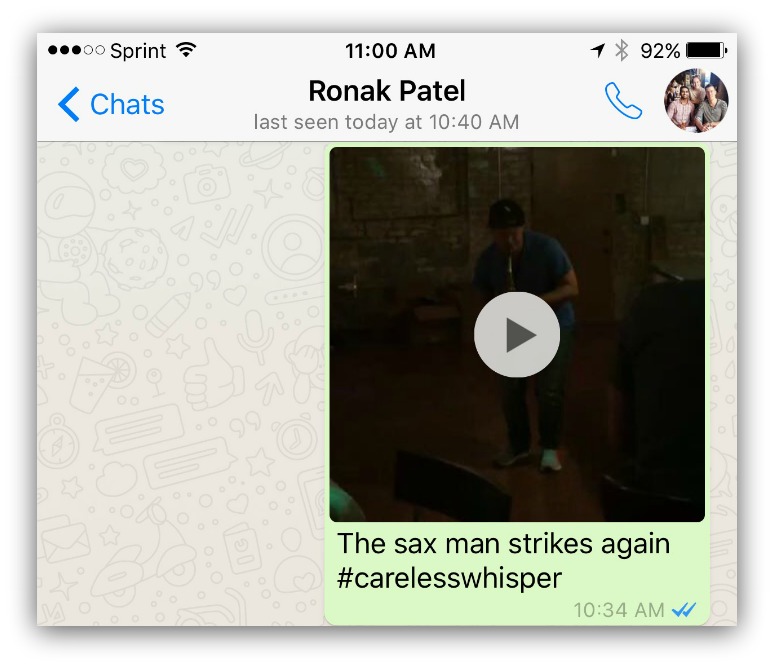
Documents:

And you can even do voice calls with WhatsApp. Just this month they passed the 100 million voice calls per day mark. It’s actually starting to overtake Skype for voice call market share.
And think about this. Facebook owns WhatsApp. The market share for Facebook Messenger and WhatsApp combined accounts for 79% of the entire messaging market.
That’s insane. As a marketer, WhatsApp gives you so many ways to communicate to an audience. Images, text, videos, voice messages…the possibilities are endless.
But you need to know who is on the other end of that app. Some countries practically rely on WhatsApp, while others are slower to adopt.
The good news? This large user base is on the brink of taking over your world.
Who Uses WhatsApp?
Let’s get this out of the way upfront. WhatsApp isn’t meteorically successful in the US quite yet.
Remember: the core of WhatsApp is free text messages. In markets like Europe and Asia, that’s a huge value proposition. Data charges are crazy high, which is why WhatsApp can come in and instantly be successful.
In the US, that’s not the case. Most carriers have offered free messaging and voice calling bundles for years now. So the appeal of free texts and calls doesn’t resonate with Americans.
But that’s not to say it isn’t catching on. Ronak Patel, the webinar genius and world traveler here at Sumo, has this take:
-
“I mainly use WhatsApp for the different friends groups and family groups that I talk to. Sharing content in it is super easy, so it’s not a pain in the ass to preview links.
-
The other big thing is talking to people internationally. I’ve got friends outside the US, and it’s free to talk to them on WhatsApp."
Americans with international friends or frequent group conversations easily see the benefits. Plus, WhatsApp nailed the content sharing formula, making iMessage users choose the app over the native iPhone SMS.
In 2014, 11% of Americans used WhatsApp. The app is slowly picking up steam, so American marketers need to ready themselves for an abrupt change in the market.
But let’s turn our eye to outside the US. There are 42 billion messages sent through WhatsApp each day, and 109 countries across the world turn to WhatsApp as their primary messaging app.
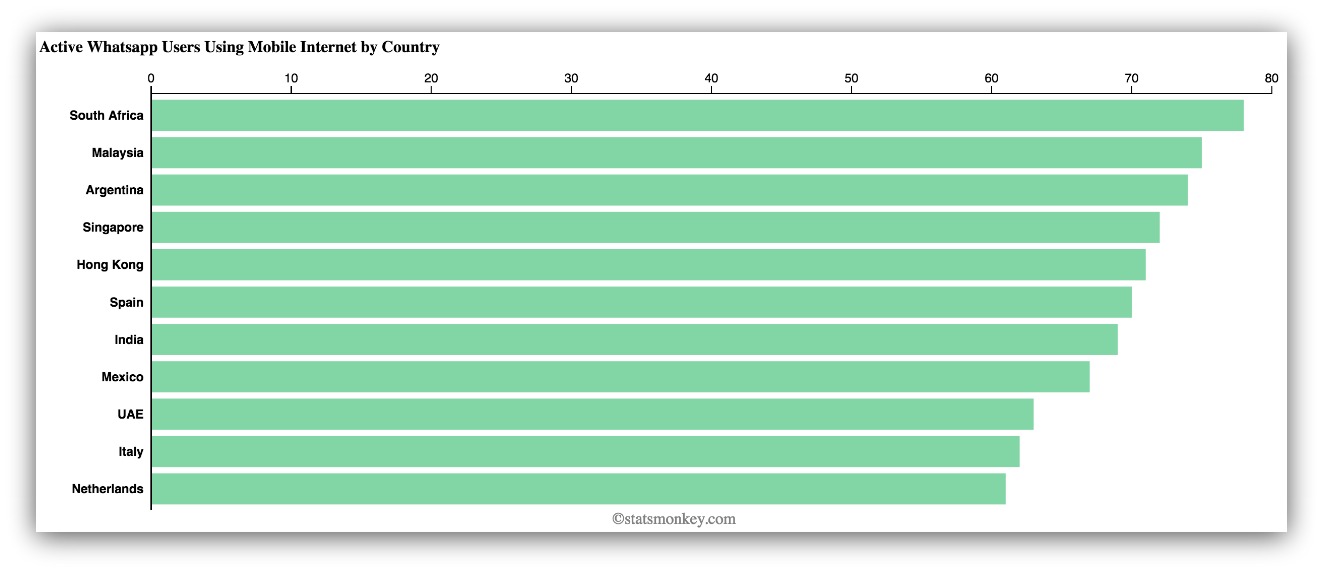
Fifty percent or more of the population in major countries like South Africa, Argentina, India, Spain, Mexico, Italy, Germany, and Brazil use WhatsApp.
And while teens in Germany and the UK are fans of WhatsApp, they’ve really hit a sweet spot with adult users:

Source: Experian Marketing Services
The sweet spot for the app is ages 25-44. So many apps and platforms bust their butt to target the 15-24 demographic, but WhatsApp wins because they’re a premier choice for adults.
Look how many adults use WhatsApp in these countries:

That consistency straight-up dwarfs Snapchat and WeChat. Adults want to communicate, and they use WhatsApp to do it.
TL:DR – WhatsApp is used heavily outside the US by adults.
As a marketer armed with this information, you face two scenarios.
- You market to an international audience, so WhatsApp needs to be on your radar ASAP.
- You market to the American audience, so you have the opportunity to be an early adopter.
Either way, WhatsApp is the platform you need to focus on for the rest of 2016 and beyond. Those in the first camp are tapping into an existing market. Those in the second camp can become early adopters and ride the wave when the app blows up in the US.
Come with me and I’ll show you how to knock down the doors of WhatsApp (before anyone else does).
The 4 Steps For Marketing on WhatsApp
Make no mistake. While WhatsApp has been labeled as an anti-marketing company, they’re about to see some big changes that’ll get the attention of every marketer on the planet.
How do I know that? Two reasons:
They’re Ready to Monetize
WhatsApp used to charge each user $1 per year. They stopped, because they didn’t want users to worry about losing contact with friends and family because they didn’t have a debit or credit card.
They are, however, going to monetize from businesses. The Facebook team is one of the best at monetizing user bases, and they’re certainly going to turn their eyes toward WhatsApp.
Forbes already predicts Facebook could make five billion dollars off WhatsApp soon:

And that revenue is dependant on business development. Hell, even Mark Zuckerberg said it’s not worth monetizing a platform until it gets one billion users.
WhatsApp hit that this year. If they’re asking for money from businesses, chances are those businesses will get to market on WhatsApp.
They’re Developing Tools for Businesses
In the same blog post, WhatsApp said they were looking to build new ways for businesses to communicate with users:
- “Starting this year, we will test tools that allow you to use WhatsApp to communicate with businesses and organizations that you want to hear from. That could mean communicating with your bank about whether a recent transaction was fraudulent, or with an airline about a delayed flight.”
They still don’t want to do ads. But they’re creating tools for businesses to communicate with users.
This combo means businesses (and marketers) are about to get unparalleled access to a platform rife with engaged users.
Here’s the problem. Once they open up to businesses, it’ll be too late for you to win.
It’s all about who can establish a presence first. Gary Vaynerchuck has made a career off being first to a new social media channel.
You have to strike first. If you can carve out a niche before everyone else, you’ll have a massive head start over every marketer.
Here’s how you can do that right now BEFORE everyone else.
Step 1. Create a WhatsApp Account
Duh. But still, there’s a lot of thought that goes into creating an account.
On the surface, it’s a straightforward process:
- Install the app on your phone
- Create a 25 (max) character name
- Select a profile picture
- Write a 139 (max) character status describing who you are
Easy, right?

You need to consider two things before you create your account:
-
Will you always have that name: Your name is permanent. The app is built for people, and people’s names rarely change. When you input your name, make sure you aren’t changing it soon. Once you choose your name, you can’t change it.
-
Will you always have that phone number: Think you can just install the app on someone’s phone? What happens if that person leaves? Or what happens if job titles change and the phone’s owner doesn’t run WhatsApp anymore? The account is bound to a singular phone number. Make sure the phone you install WhatsApp on is going to be around for a while.
Those are the big questions to consider before you create an account.
Some Good Questions
Q: Should I use a picture of me in my WhatsApp profile or of the brand?
A: Your brand. Because your brand may be a company name OR it may be you. If you work at a company and you’re using your personal image as the brand, think again.
Q: What should I put in my status? Do people look at my profile?
A: People rarely look at a status. It’s like opening up your contacts list and looking at each individual contact. If you’re curious as to how many people look at your profile, you can use the WhatsApp Mobile Viewer (WARNING: This is a third party app not affiliated with WhatsApp).
Q: Where can I put a URL to my site?
A: In your status. You have 139 characters to use, and you can certainly include a URL to your site. However, the link isn’t clickable, so you have to hope someone copies and pastes your URL into a browser.
Q: Then how can I use my status to drive traffic?
A: WhatsApp is different from Facebook, Twitter, and Instagram because links you post aren’t clickable. Because of that, your status won’t be the best place to drive traffic. You’ll want to use your messages to do that.
Ok, easy part over. You’ve got an account. It’s….there. Collecting dust.
So let’s fill up that contact list.
Step 2. Filling Your WhatsApp Contact List
Here’s the fun part. When you talk to most marketers, they’ll say WhatsApp isn’t viable because there isn’t an easy way to build an audience.
Of course there isn’t an easy way. That’s what makes it worth it.
This is permission-based marketing in its purest form. You have to ask people to join AND you have to give them a great reason to join your group. Especially since they’re giving you their cell phone number.
Since you can’t search for users or pay to acquire them, you have to rely on two methods for growing your WhatsApp following.
1. Give Them Your Number, They Add You
This is the easier of the two methods because you’re not even asking a visitor to give up their number. This is you trusting your number to the masses and giving them the choice to add you.
(Hint: This is why I suggest getting a dedicated phone for a business WhatsApp account. If you’re using your own number, you’re essentially giving out your personal number.)
News outlets in Europe have used this method to build up massive followings. The best example comes from the BBC, as they set up an Ebola Crisis WhatsApp channel for users to receive up to three health alerts daily.
They saw 25,000 people sign up for that group. And all they did was this:

They included that message on articles, emails and promotional pieces. But take note how they ask you to join.
If someone were to add their number and not text ‘JOIN,’ the BBC wouldn’t be able to send them messages. You can’t see if someone adds your number to their contact list. You only know they have your number once they send a message.
Once they text you with whatever code you choose, you manually (ugh, I know) add their number to your contacts list and VOILA…you’ve got their number.
You can take a page from BBC’s playbook and mention it in your articles, but a nice “set it and forget it” solution is including an ask in your email signature.
It takes ten seconds to do and it gives your emails a bit more marketing power. It can even be as simple as this:

Disclaimer: Please don’t text that number.
That does the job of asking the reader to respond to your number. PLUS, it gives the value prop in the description — aka the “why.”
2. Get Their Number, You Add Them
And this tactic involves more than meeting up at a bar and saying “Gimme yo numbah.”
It’s also a little harder than the first tactic. Now you’re asking for someone’s phone number which, if we use my college dating life as a baseline, can be a very difficult thing.
However, you’re eliminating an acquisition step with this method:

The previous method places a lot of responsibility on the user. Not only do they have to add you on WhatsApp, but they have to text you, too. For them, there’s no value in that second action. They’d rather add you and be done.
This second method cuts that step but places more work on you (yay!). The user simply gives their phone number to you. It’s up to you to take that number and add it into your contact list.
Granted, there are the standard ways of presenting this ask (Facebook, Twitter, asking your friends). But let me give you a unique way that can drive signups.
“POP UP” ON MOBILE DEVICES
Pardon the pun. But if you want to take it a step further, you can specifically target mobile users. They’re the ones able to access WhatsApp easier, right?
You can target those users with a pop-up, and you don’t even need special coding expertise or a degree from MIT to do it. You can set up a List Builder or Scroll Box pop-up, then do this:
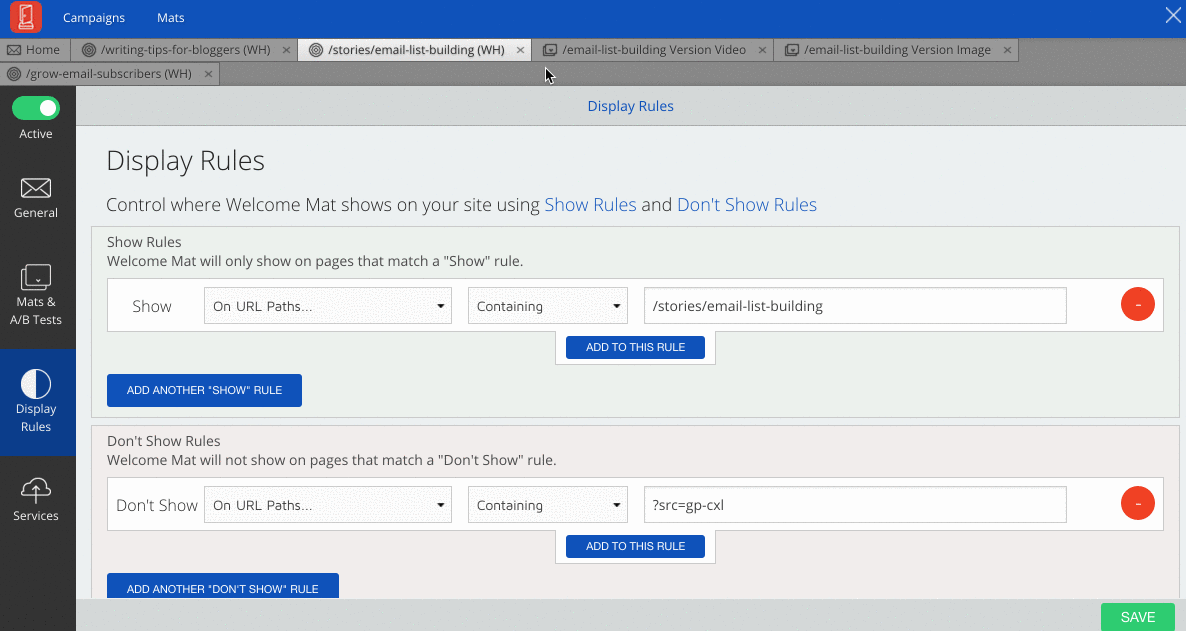
You can see 9 other ways to segment your audience here.
Then any pop-up you create will show up for mobile users:

And again, from there you have to manually enter the number into your WhatsApp account.
A Good Question
Q: How do I get followers on different platforms to follow me on WhatsApp?
A: It’s as simple as asking. A tweet with your number on Twitter, a post on Facebook mentioning your number, an Instagram image with your number…like anything, you just have to ask. This opens you up to adding people that aren’t on your email list, meaning more opportunities to convert visitors.
Got some numbers? Great!
Now what?
Step 3. Organize Your Contacts Into Groups
You can message people 1-to-1 (we’ll talk more about that later). But, most likely, you’ll want to send one message to as many people as possible.
That’s why you need to create groups within WhatsApp. The problem is, there are some restrictions that apply:
-
You Have to Create The Groups Yourself: Not a big deal, but worth noting. You can’t search for existing groups like in LinkedIn, and every group you create is private.
-
You Have To Add All The Numbers: Yep, more numbers. You have to physically type in all the numbers you collect into the individual groups.
-
You Have A Max Group Size: Group sizes keep going up, but they’re still not massive. You can create a group up to 256 people. However, you can have unlimited groups. So while not everyone can be in the same group, you can create duplicate groups for your subscribers. (NOTE: Though bigger groups and public groups could be near.)
Things To Consider When Making Groups
-
Who Will Be In Your Group: Since you’re limited to 256 people per group, you have to decide who will be in which group. All girls in one and guys in another — college-style? Segment by age? Mix everyone together? It’s up to you.
-
What Will The Dynamics of Each Group Be: Different combinations of people will produce different dialogues in these groups. As you add people to groups, think about the demographics and psychographics of your groups.
-
Will You Move People Between Groups: What happens if some people respond quite a bit but others don’t? Do you move them to a new group? Consider overall dynamics and how your audience will feel if they’re moved from group to group.
Good news. If you got through this, then you made it through the most difficult, time-consuming part of WhatsApp. You’ll have everyone in a group, ready to interact with you and your audience.
Now you get to do the fun stuff.
Step 4. Interacting With Your Audience
This is where WhatsApp gets me all hot and bothered (in a good way) as an early-adopter marketer. The possibilities are mouth-wateringly tantalizing.
Think of this platform as email on steroids. Not only can you communicate one to many, but you can communicate one to one for highly personalized interaction.
And they’ll open your message, too. DigitalDefynd found that your message has a 70% chance to be opened. Email can’t touch that.
So when I look out onto the WhatsApp horizon, I see five ways you can use this app right now to build a massive following (before they open the app up to businesses).
Treat It Like An Email
Me: Quick, what do you use emails for most?
Everyone: Pushing people to a web page, of course.
Exactly.
WhatsApp can do that. This might be the most obvious use of WhatsApp, but it’s also the most straightforward. Send a link → they see the message → they click → mission accomplished.
We’re talking articles, product pages, landing pages, videos…anything with a link, you can send it:

For those screaming “IT’S NOT TRACKABLE”…fear not. You can always create a UTM code with the Google URL Builder. You insert your link, answer a couple questions about where this link is posted and you get this:
Bonus points if you know what groups these are by the logos.
The value from these groups is phenomenal. Take this group for example:

There are 50 channels and I’m in 15 of them. It all ranges from content marketing ideas to SEO to even finding a job (the one job search strategy they don’t write about on LinkedIn).
The common thread between all these channels? I can:
- Bounce ideas off other people
- Network
- Share my articles/pages with everyone
Name another place you can do all three of those things instantaneously. It’s slim pickings, that’s for sure.
But wait. Add WhatsApp to that super short list.
Treat your WhatsApp groups like a Slack channel. You can create groups for networking, talking through ideas and sharing things. Sites already do this with “Mastermind Channels” on Facebook where people pay to be part of the action.
You can market your WhatsApp channels the same way. Free or paid, they can be a valuable hub for your audience to connect with one another.
Daily Tips, Right To Your Phone
How would you like a daily marketing tip from Noah Kagan?
Sounds pretty cool. Especially if those tips were delivered in a simple text message.
That’s the power of WhatsApp. It’s like a more intimate Twitter. Sure, you can connect to an athlete or famous person. And they can even tweet out a nice inspirational quote.

But getting an SMS message in your inbox from that celebrity? Very useful.
It’s a pure branding play, because there aren’t any goals you can attach to this strategy. But that repeat, daily engagement makes your audience more likely to engage back.
Get Down In The Trenches With Market Research
Big or small, you want to know what your audience wants. You can stand around in meetings and make generalizations like, “Well, I don’t feel like people would like this because (INSERT WEIRD REASON).”
OR, you could get down in the trenches and individually ask your users what they like.
Enter WhatsApp.
What seems easier to reply to? Yet another email in your inbox, asking to take a survey with nothing in return?
Or a text like this:

Quick, simple and to the point. It’s not buried in an inbox and it isn’t laced with needless images or introductory fluff.
It’s like you’re having an informal conversation with a friend. It takes the pressure off responding to some faceless corporation. You can dig deep with this strategy and ask things like:
- User likes and dislikes
- Wishlists for future features
- Why they’re using your service
- If they’d recommend your service to a friend
Don’t waste money sending out emails to your users. Add them on WhatsApp and have an organic, real conversation with them.
Give The Middle Finger To Unopened Emails
Alright. Technically I’m cheating by listing a sales use.
But be honest. How many of you marketers also double-time it as salespeople?
The line blurs when you’re a small (or medium) sized business. And losing a potential customer because of a communication breakdown can feel like a backbreaker.
That’s why companies like ProfitBooks are starting to use WhatsApp to connect with their sales leads. They found that using WhatsApp in lieu of a phone call led to a 40% increase in responses.
Why? Because people would rather respond to a quick text than a call that could go on forever.
It’s the perfect way to qualify your leads and protect your valuable time. The response from a short text can help determine if someone is ready to jump on a call. That level of qualification ensures you’re only taking the calls that matter.
From ProfitBooks:
-
“No one appreciates phone calls from unknown numbers but we are more likely to respond to personal messages. When we start using WhatsApp for customer communication, we noticed better response and engagement.
-
This also gives an opportunity to be little informal. For example, you’ve sent a quote to your potential customer but haven’t heard from them, what do you do? You either call them or send a followup mail using formal language. Instead of doing this, if you just send a short message on WhatsApp asking about the status, you might get a quick response.”
Some Good Questions
Q: How can I get more traffic from WhatsApp? Can I post call to actions somewhere to an opt-in offer?
A: Absolutely. That’s where you leverage the ability to send beautiful links to your subscribers. Think of a WhatsApp message like a Facebook post. You can write as long or as short a message you want, then post a link to whatever page you want to drive traffic to.
Q: Which type of media is the most powerful to send to audience on WhatsApp?
A: As of now, there’s no consensus. Successful media outlets like BBC have used standard text and link messages to update their subscribers. WhatsApp is a mix of Instagram, Snapchat, Voxer and Facebook Messenger rolled into one. However you want to convey a message, WhatsApp can handle it.
Q: What if I’m not a marketer? Can I use WhatsApp for other businesses?
A: WhatsApp knows no bounds. The core of this app is like any other — to interact and connect. Say you’re…
- A chef. You can send images of delicious food or links to new recipes.
- A personal trainer. You can post your location for spontaneous fitness meetups, or videos of new exercises.
- A crafter. You can post links to DIY pages or pictures of new crafts for sale.
- A beauty consultant. You can send voice messages giving daily tips or links to your new beauty products.
The possibilities are limitless.
Add A Comment
VIEW THE COMMENTS